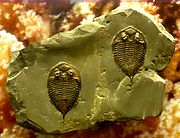
Dalmanites
Encyclopedia

Trilobite
Trilobites are a well-known fossil group of extinct marine arthropods that form the class Trilobita. The first appearance of trilobites in the fossil record defines the base of the Atdabanian stage of the Early Cambrian period , and they flourished throughout the lower Paleozoic era before...
in the order Phacopida
Phacopida
Phacopida is an order of trilobite that lived from the Ordovician to the Devonian. It is made up of a morphologically diverse group of related suborders....
.
The trilobites of this genus have slightly convex exoskeleton
Exoskeleton
An exoskeleton is the external skeleton that supports and protects an animal's body, in contrast to the internal skeleton of, for example, a human. In popular usage, some of the larger kinds of exoskeletons are known as "shells". Examples of exoskeleton animals include insects such as grasshoppers...
s with an average diameter of 4–7 cm (1.5 - 2.75 in). The cephalon is semicircular or parabolic. The glabella (center portion of the head) is often pear-shaped, and tapers outward toward the front. The glabella also always contains three pairs of obvious glabellar furrows. Also prominent are the large mosaic (schizochroal) eyes.
The thorax is composed of six to eleven pleural ribs, with the relatively large pygidium
Pygidium
The pygidium is the posterior body part or shield of crustaceans and some other arthropods, such as insects and the extinct trilobites. It contains the anus and, in females, the ovipositor...
being composed of several additional fused segments. The pygidium ends in a striking tail spike.
During the Ordovician
Ordovician
The Ordovician is a geologic period and system, the second of six of the Paleozoic Era, and covers the time between 488.3±1.7 to 443.7±1.5 million years ago . It follows the Cambrian Period and is followed by the Silurian Period...
and Silurian
Silurian
The Silurian is a geologic period and system that extends from the end of the Ordovician Period, about 443.7 ± 1.5 Mya , to the beginning of the Devonian Period, about 416.0 ± 2.8 Mya . As with other geologic periods, the rock beds that define the period's start and end are well identified, but the...
periods, the genus Dalmanites was widespread all over the world, inhabiting a variety of climates and sea conditions.

